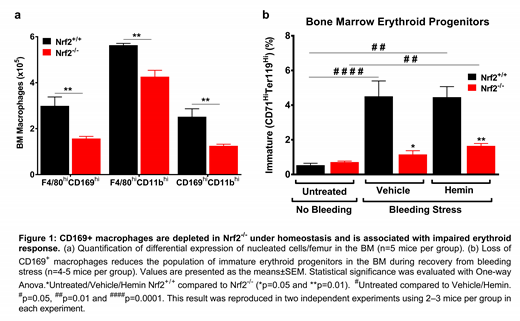Erythropoiesis occurs in specialized niches in the bone marrow consisting of a central macrophage, surrounded by differentiating erythroblasts. This central macrophage has been identified by several markers including, CD169 (Sialoadhesin or Siglec-1), F4/80, CD11b, VCAM-1, ER-HR3 and Ly-6G. These CD169+ macrophages support erythropoiesis both at steady state and during stress. Nuclear factor erythroid 2-related factor 2 (Nrf2) is the master regulator of the cellular oxidative defense system. It modulates hematopoietic stem cells but its loss produces no visible phenotype in steady state hematological parameters. However, the importance of Nrf2 and macrophage subsets has not been fully characterized during recovery from stress erythropoiesis. We examined specific subsets of CD169+ macrophage populations in Nrf2 knockout (Nrf2−/−) mice as well as the role of Nrf2 in recovery from stress erythropoiesis in vivo.
We quantified the expression of CD169, F4/80 and CD11b, markers of central macrophages, in the BM and spleen of Nrf2+/+ and Nrf2-/- mice at steady state. Surprisingly, Nrf2-/- mice showed a phenotype characterized by lower percentages of cells expressing known macrophage markers. We observed a significant decrease of 47% (p≤0.01), 24% (p≤0.01) and 50% (p≤0.01) in BM macrophage subpopulations expressing F4/80hiCD169hi, F4/80hiCD11bhi and CD169hiCD11bhi respectively, in age-matched Nrf2-/- mice compared to Nrf2+/+ control mice (Fig. 1a). In the spleen, we also observed a similar significant deficiency in BM macrophages (p≤0.01). Further validating this phenotype, immunofluorescence staining of isolated spleen tissue showed that expression of CD169+ macrophages was dramatically lower in spleen sections of Nrf2-/- mice than in Nrf2+/+ control mice. We hypothesized that our macrophage-deficient mice would display a defect in recovery from blood loss. Five to seven days after acute blood loss, immature erythroid progenitors (CD71hiTer119hi) increased in marrow by about 5-fold in Nrf2+/+ mice (p≤0.001, Fig. 1b), and mature erythroid progenitors (CD71loTer119hi) increased in marrow by 12-fold (p≤0.05) but the erythroid marrow response was impaired significantly in the macrophage deficient Nrf2-/- mice. To extend our observations regarding macrophage deficiency and impaired erythroid response, we chose a more functional outcome of recovery from anemia after high-grade blood loss produced by daily phlebotomies over 3 consecutive days to induce stress erythropoiesis in Nrf2+/+ and Nrf2-/- mice. We found significantly lower packed cell volume values specifically on Days 2, 4 and 10, implying delayed erythroid recovery (p≤0.05, two-way ANOVA). The Nrf2-/- mice also showed a significant decline in total hemoglobin than the Nrf2+/+ mice (p≤0.05). Additionally, peripheral blood reticulocyte response to blood loss is delayed in Nrf2 deficient mice compared to age-matched controls (11.0 ± 0.6% vs. 14.8 ± 0.6%, p≤0.001). We analyzed expression of heme-oxygenase 1 (HO-1), a well-known Nrf2-regulated gene. HO-1 mRNA expression increased 3-fold and 23-fold in Nrf2+/+ mice animals subjected to phlebotomy and hemin treatment compared to 2-fold and 12-fold expression in Nrf2-deficient mice (p≤0.05).
We demonstrate for the first time that Nrf2-deficient mice have a deficiency of macrophages that includes subsets considered erythroblastic island (EI) macrophages, and that this deficiency is associated with impaired erythroid response to induced stress. Secondly, our multiple phlebotomies data in aggregate demonstrate that Nrf2-/- mice deficient in BM macrophages have significant delay in functional erythroid response and recovery from experimentally-induced anemia. Thirdly, impaired inducibility of HO-1 is a known feature of Nrf2-/- mice, which we confirmed in our results, could be contributing to the impairment in erythroid response. However, it is not likely that restricted iron trafficking to erythroid progenitors occurs in Nrf2-/- mice, since there is no characteristic alteration of mean corpuscular volume and mean corpuscular hemoglobin in peripheral blood. This is an area worthy of additional investigation. We conclude that the Nrf2 gene plays a previously unappreciated role in erythroid biology that appears to be mediated through macrophage function.
Ofori-Acquah:Shire Human Genetic Therapies Inc: Other: Financial Relationship. Kato:Bayer: Research Funding; Novartis, Global Blood Therapeutics: Consultancy, Research Funding.
Author notes
Asterisk with author names denotes non-ASH members.


This feature is available to Subscribers Only
Sign In or Create an Account Close Modal